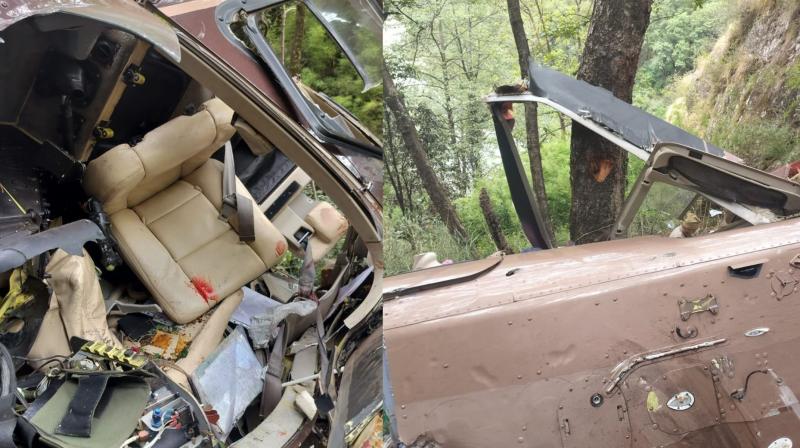Engineer warned of structural damage before Florida building collapse

KATHMANDU: JUNE 27 – Three years before the deadly collapse of the Champlain Towers South condominium complex near Miami, a consultant found alarming evidence of “major structural damage” to the concrete slab below the pool deck and “abundant” cracking and crumbling of the columns, beams, and walls of the parking garage under the 13-story building.
The engineer’s report helped shape plans for a multimillion-dollar repair project that was set to get underway soon — more than 2 1/2 years after the building managers were warned — but the building catastrophically collapsed in the middle of the night Thursday, crushing sleeping residents in a massive heap of debris.
The complex’s management association disclosed some of the problems in the wake of the collapse, but it was not until city officials released the 2018 report late Friday that the full nature of the concrete and reinforcing bar damage — most of it probably caused by persistent water leaks and years of exposure to the corrosive salt air along the South Florida coast — became chillingly apparent.
“Though some of this damage is minor, most of the concrete deterioration needs to be repaired in a timely fashion,” the consultant, Frank Morabito, wrote about damage near the base of the structure as part of his October 2018 report on the 40-year-old building in Surfside, Florida. He gave no indication that the structure was at risk of collapse, although he noted that the needed repairs would be aimed at “maintaining the structural integrity” of the building and its 136 units.
In a statement Saturday, Morabito’s firm, Morabito Consultants, said it provided the condo association with both an assessment of the “extensive and necessary repairs” needed and an estimate of how much they would cost.
“Among other things, our report detailed significant cracks and breaks in the concrete, which required repairs to ensure the safety of the residents and the public,” the statement said.
Emails show that the secretary of the condo association forwarded the report to an official in the town’s building department on Nov. 13, 2018. The town did not disclose any further correspondence related to the report.
Mayor Charles Burkett of Surfside said Saturday he did not know what, if any, steps were taken to examine the problems further.
“Of course there should have been follow up,” he said. “And I don’t know that there wasn’t. I think we need to understand exactly what happened at that time.”
Mayor Daniella Levine Cava of Miami-Dade County said officials there knew nothing of the 2018 report. On Saturday, she announced a 30-day audit of all buildings 40 years and older under the county’s jurisdiction, and she urged cities to do the same for buildings within their borders.
“We want to make sure that every building has completed their recertification process,” she said. “And we want to make sure to move quickly to remediate any issues that may have been identified in that process.”
The condominium complex had been preparing for the recertification that state law requires of similar buildings in the area that have reached 40 years of age and was on notice that it needed to complete the repairs in order to pass inspection.
But solving the problem of water leaking down from the pool area into the garage was going to involve major work and cost millions of dollars. Brad Sohn, a lawyer representing at least one resident who has filed a lawsuit against the Champlain Towers South Condominium Association, said Saturday that residents were facing assessments ranging from $80,000 to as high as $200,000.
Sohn said he was still trying to understand why repairs had not begun immediately after the 2018 report outlining the major problems with the building.
“There is no acceptable answer to that question — period, full stop,” he said.
Donna DiMaggio Berger, a lawyer who represents the resident-led association that operates the building, said Saturday that while the report outlined problems to fix, the condo board had no warning that there was a major safety risk.
“If there was anything in that report that really outlined that the building was in danger of collapse, or there was a hazardous condition, would the board and their families be living there?” she said. She noted that one board member, Nancy Kress Levin, was missing in the collapse, as were her adult children.
The association had taken out a $12 million line of credit to pay for the repairs and was going through a careful, step-by-step process to get them done, Berger said. She said that such a process could seem more like moving a commercial tanker than a speedboat, always involving pushback and debate as board members decided on what to tackle first and how much of a cost to impose on homeowners. “Nobody likes a special assessment,” she said.
The coronavirus pandemic also slowed progress on getting repairs underway, she said.
Eliana Salzhauer, a Surfside commissioner, said that while the cause of the collapse was unknown, it appeared to her that the problems identified by the engineer in the 2018 report could have contributed to the structural failure.
“It’s upsetting to see these documents because the condo board was clearly made aware that there were issues,” Salzhauer said. “And it seems from the documents that the issues were not addressed.”
Investigators have yet to identify the cause and are still awaiting full access to a site where rescue crews have been urgently sifting through an unstable pile of debris for possible survivors.
On Saturday, local officials said they had not given up hope of finding live victims beneath the rubble but acknowledged the difficulty of their task. A fire was burning below the debris of the collapsed building, sending smoke billowing into the air and complicating the search. Rescuers said they were not hearing any signs of life, and 159 people remained missing.
Experts said that the process of assessing what ultimately caused the building’s structure to fail could take months, involving a review of individual building components that may now be buried in debris, the testing of concrete to assess its integrity, and an examination of the earth below to see if a sinkhole or other subsidence was responsible for the collapse.
The building was just entering a recertification process for aging structures that have endured the punishment of coastal Florida’s hurricanes, storm surges, and the corrosive salty air that can penetrate concrete and rust the rebar and steel beams inside.
The 40-year requirement was put in place after a building collapse in Miami in 1974 that killed seven people. The Drug Enforcement Administration, which operated in the building, said officials later determined that the resurfacing of a parking lot on the roof of the building, combined with salt, had weakened the supporting steel structure of the building.
Morabito, who declined to comment this past week, wrote in the 2018 report that the goal of his study was to understand and document the extent of structural issues that would require repair or remediation.
“These documents will enable the Condominium Board to adequately assess the overall condition of the building, notify tenants on how they may be affected, and provide a safe and functional infrastructure for the future,” he wrote.
At the ground level of the complex, vehicles can drive in next to a pool deck where residents would lounge in the sun. Morabito in 2018 said that the waterproofing below the pool deck and entrance drive was failing, “causing major structural damage to the concrete structural slab below these areas.”
The report added that “failure to replace the waterproofing in the near future will cause the extent of the concrete deterioration to expand exponentially.” The problem, he said, was that the waterproofing was laid on a concrete slab that was flat, not sloped in a way that would allow water to run off, an issue he called a “major error” in the original design. The replacement would be “extremely expensive,” he warned, and cause a major disturbance to residents.
In the parking garage, which largely sits at the bottom level of the building, part of it under the pool deck, Morabito said that there were signs of distress and fatigue.
“Abundant cracking and spalling of varying degrees were observed in the concrete columns, beams, and walls,” Morabito wrote. He included photos of cracks in the columns of the parking garage as well as concrete crumbling — a process engineers refer to as “spalling” — that exposed steel reinforcements on the garage deck.
Morabito noted that previous attempts to patch the concrete with epoxy were failing, resulting in more cracking and spalling. In one such spot, he said, “new cracks were radiating from the originally repaired cracks.”
The report also identified a host of other problems: Residents were complaining of water coming through their windows and balcony doors, and the concrete on many balconies was deteriorating.
After watching a surveillance video showing the collapse of the building, Evan Bentz, a professor at the University of Toronto and an expert in structural concrete, said that whatever caused the collapse would have to have been somewhere near the bottom of the building, perhaps around the parking level. Although he had not seen the 2018 report at the time, he said such a collapse could have several possible explanations, including a design mistake, a materials problem, a construction error or a maintenance error.
“I’d be surprised if there was just one cause,” Bentz said. “There would have to be multiple causes for it to have fallen like that.”
Other concerns about the complex have been raised over the years. One resident filed a lawsuit in 2015 alleging that poor maintenance had allowed water to enter her unit through cracks in an outside wall. Some residents expressed concern that blasting during construction at a neighboring complex had rattled their units.
Researchers analyzing space-based radar had also identified land that was sinking at the property in the 1990s. A 2020 study found subsidence in other areas of the region, but on the east side of the barrier island where Surfside is, the condo complex was the only place where the issue was detected.
Morabito Consultants said the company was engaged in June 2020 to prepare a “repair and restoration plan” for fixes needed under the state recertification requirements. At the time of the collapse this week, the company said, roof repairs were underway but concrete restoration, which was to be handled by another firm, had not begun.
The collapse has stunned industry experts in the Miami area, including John Pistorino, a consulting engineer who designed the 40-year reinspection program when he was consulting for the county in the 1970s.
He touted other regulations that have come since, including requirements that tall buildings have an independent engineer verify that construction is going according to plans.
Pistorino did not want to speculate on the cause of the collapse. But he said that while some buildings in the region have had quality problems, any serious deficiencies were unusual, and were typically easy to detect by way of glaring cracks or other visible problems.
“This is so out of the norm,” Pistorino said. “This is something I cannot fathom or understand what happened.”










